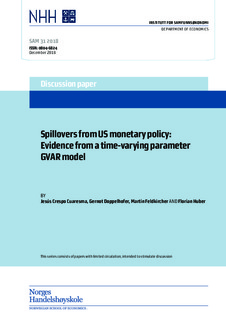Spillovers from US monetary policy: Evidence from a time-varying parameter GVAR model
Working paper

Åpne
Permanent lenke
http://hdl.handle.net/11250/2578947Utgivelsesdato
2018-12-21Metadata
Vis full innførselSamlinger
- Discussion papers (SAM) [657]
Sammendrag
This paper develops a global vector autoregressive (GVAR) model with time-varying parameters and stochastic volatility to analyze whether international spillovers of US monetary policy have changed over time. The proposed model allows assessing whether coefficients evolve gradually over time or are better characterized by infrequent, but large breaks. Our findings point towards pronounced changes in the international transmission of US monetary policy throughout the sample period, especially so for the reaction of international output, equity prices, and exchange rates against the US dollar. In general, the strength of spillovers has weakened in the aftermath of the global financial crisis. Using simple panel regressions, we link the variation in international responses to measures of trade and financial globalization. We find that a broad trade base and a high degree of financial integration with the world economy tend to cushion risks stemming from a foreign shock such as a US monetary policy tightening, whereas a reduction in trade barriers and/or a liberalization of the capital account increase these risks.